Burnout model
Now that we’ve explored all the tangents, let’s integrate these reflections with the current burnout research in a personal graphical model of burnout.
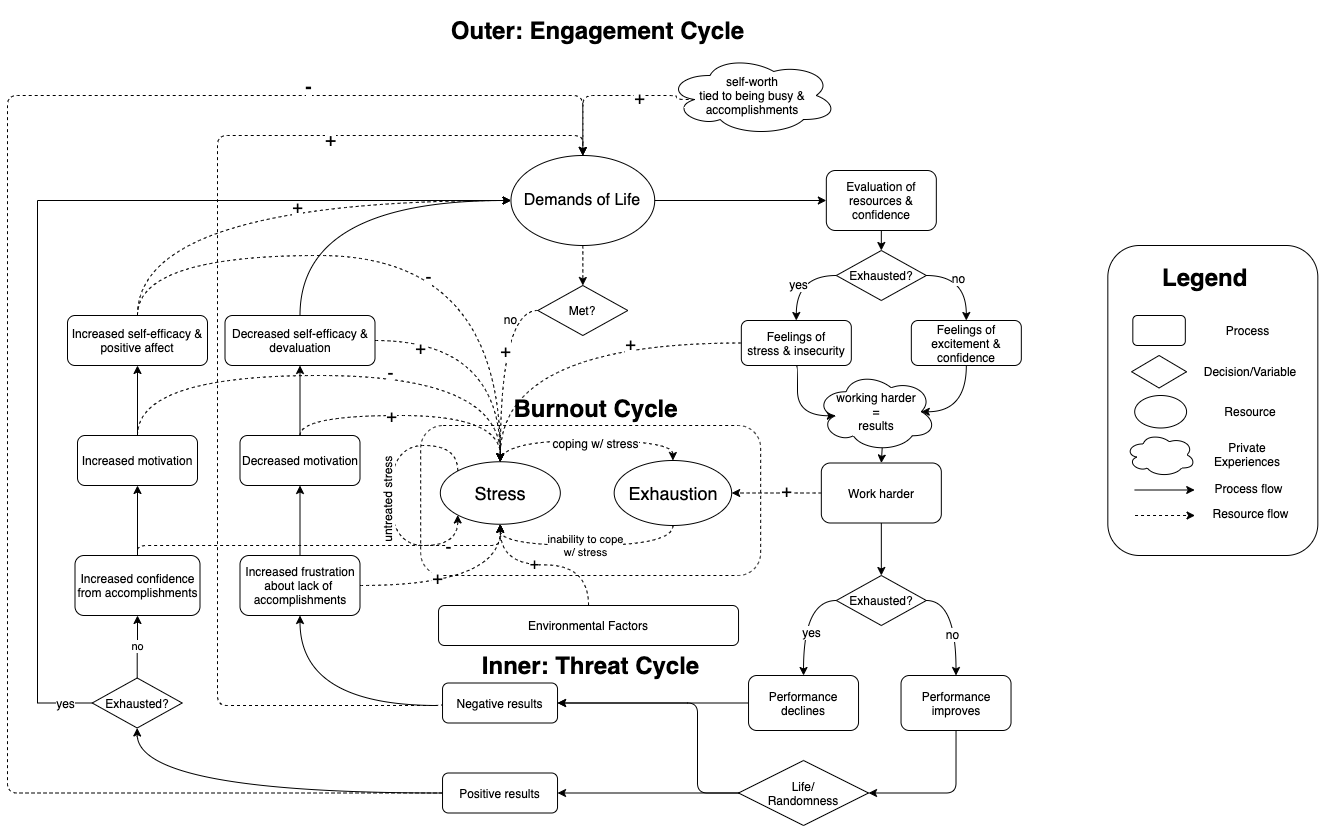
Don’t worry yet if you don’t understand anything about it. We’ll break down this model into its component parts. The key thing to note is that this model consists of 3 cycles. The outer most cycle called the “Engagement Cycle”. It is the process of life when we are living a satisfying life. The cycle underneath is called the “Threat Cycle”, it is the process of life that leads to the last cycle, the “Burnout Cycle.” Let’s go through these in more detail.
Engagement Cycle¶
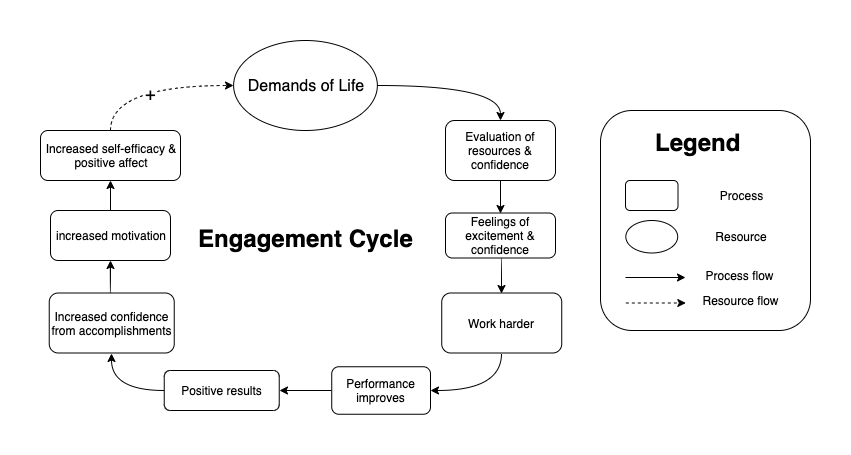
When reflecting on my burnout, I remember fondly of periods of time in which I was super engaged with my life. I needed a way to account for the cycle that helped me accomplish a lot of what I have in life. I recognized that by working hard, I was getting positive results and positive emotions, which made me more confident and able to take on more bigger challenges, which in turn increases my demands of life.
Note
A process flow refers to causality of processes that happen. For example a process flow might be "I let go of an apple in my hand" -> "The apple falls". In the above diagram there is a causal relationship between "working harder" and "performance improves".
A resource flow refers to relationship between entities that contribute to the quantity of a thing. For example, "raining" --> "water" would demonstrate that raining creates more water. In the above diagram, increasing feeling self-efficacy would increase the demands of life.
Threat Cycle¶
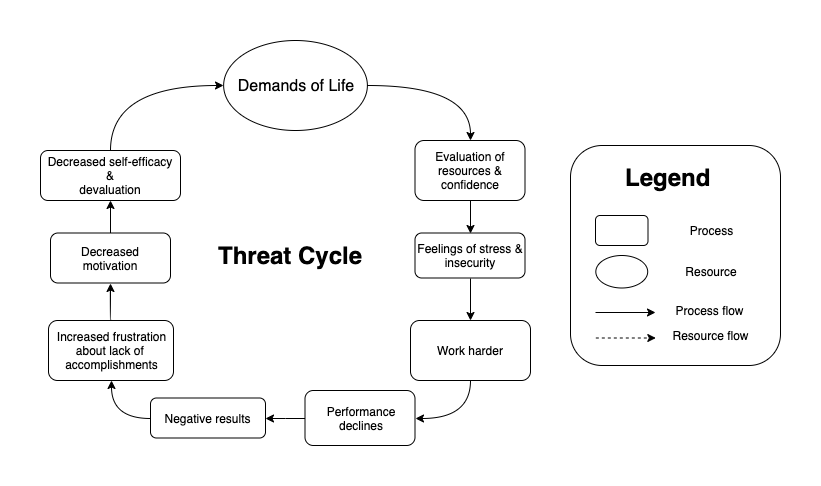
Ronald E. Smith called this the burnout cycle, but I changed the name to the “Threat Cycle” because running the cycle itself isn’t a good diagnosis of burnout and because I believed the true “no turning back point” of burnout only occurs at the point when the Burnout Cycle starts to spin and sustain itself. However the Threat Cycle and the Burnout Cycle are highly correlated. Enough iterations on the Threat Cycle and you’ll have enough stress to start a self-sustaining Burnout Cycle.
The threat cycle is named after sports psychologist Marc Jones’ “A Theory of Challenge and Threat States in Athletes” (TCTSA) paper, which explores how athletes appraise demands of their sports as challenges (positive) or threats (negative). TCTSA has shown how cognitive appraisals lead to different endocrine pathways that either result in engagement or withdrawal.
I personally renamed “challenge” to “engagement” because linguistically “challenge” still has the potential to come off negatively, which was not my purpose. “Threat” concisely describes the dominant attitude/feeling when running the threat cycle, which makes the name feel apt.
As I feel unable to meet the demands, I produce feelings of insecurity and contribute to stress. Unfortunately, my effort-oriented mindset makes me continue pushing harder with limited output and performance. My performance and work suffers and I get negative results, and the emotional burden of bad results contribute psychological stress to my stress levels, slowly jump-starting the burnout cycle.
The Vicious Burnout Cycle¶
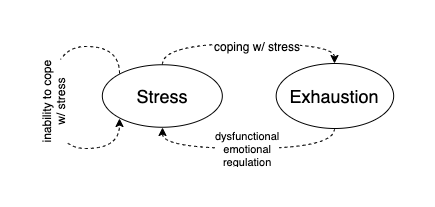
Like overwhelming interest payments, at some point we experience too much stress and not enough energy to manage our stress levels. Coping with stress takes energy, as discussed in Rest. When we’re exhausted, we have dysfunctional emotional regulation and that lets stressful events (external or internal) do more psychological harm, which contributes to stress. Remember that research has shown burnout vicious cycle at a biological level:
Burnout and the Brain (Source)
Savic theorizes that overactivation in the amygdala leads to impaired modulation of the mPFC (Medial prefrontal cortex) regions, which then triggers further stimulation of the amygdala — leading to even more activation of the mPFC. As this cycle spirals further out of control over time, neural structures begin to show signs of wear and tear, which lead to cortical thinning as well as memory, attentional, and emotional difficulties.
This very inner cycle in the condition of burnout that makes treating burnout more complicated than simply lowering the demands of our life. When burnout is severe, you have to break this burnout cycle. It takes work because the default state of burnout state is that you stay burnt out.
Transition Points: How Engagement Becomes Burnout¶
The most important transition variable in burnout is exhaustion. As we discussed in the Exhaustion section, exhaustion plays a sinister role in burnout. As exhaustion levels build, it becomes harder and harder to sustain an engagement cycle and slowly positive loops of the engagement cycle become negative loops in the threat cycle. The distribution shifts and you end up with unhealthy amounts of stress and exhaustion that start the burnout cycle.
Another transition point worth highlighting in this diagram is the role of life and randomness. Even if you are engaged, life happens, and you might not get the results you seek. Negative results hurt and increase the chances of psychological damage. This is referenced in the Working Harder = Results section in the guide.
Something to note about the Engagement-Threat cycles is that there is a common thread that runs between the two -- the role of stress. Robert Sapolsky in his book “Behave” has this excerpt:
Behave, Robert Sapolsky, pg 135
We love stress that is mild and transient and occurs in a benevolent context. The stressful menace of a roller-coaster ride is that it will make us queasy, not that it will decapitate us; it lasts for three minutes, not three days. We love that kind of stress, clamor for it, pay to experience it. What do we call that optimal amount of stress? Being engaged, engrossed, and challenged. Being stimulated. Playing.
...
This brings up a key concept, namely the inverted U. The complete absence of stress is aversively boring. Moderate, transient stress is wonderful—various aspects of brain function are enhanced; glucocorticoid levels in that range enhance dopamine release; rats work at pressing levers in order to be infused with just the right amount of glucocorticoids. And as stress becomes more severe and prolonged, those good effects disappear (with, of course, dramatic individual differences as to where the transition from stress as stimulatory to overstimulatory occurs; one person’s nightmare is another’s hobby).
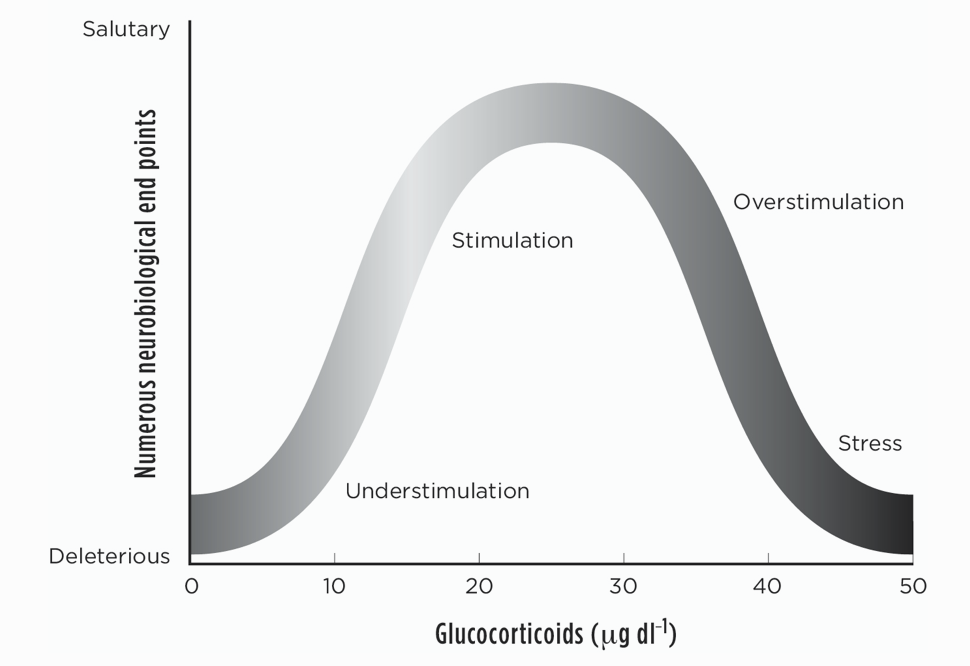
That’s right, we’ve treated stress as the villain of this entire story, but reality is often more subtle than that. Engaging with our lives IS stressful, but it’s often at the right amount of stress that we’re the most happy and engaged. When people aren’t experiencing burnout, it’s easy to draw a straight stimulation-happiness line to the top-right without recognizing the underlying role stress plays. For me, it was the same, and this inverse-U shape diagram shows how we can go from being engaged to being stressed.
How Burnout Becomes Depression¶
Revisiting a point discussed earlier about burnout and depression, here’s how I see my burnout transitioning into depression.
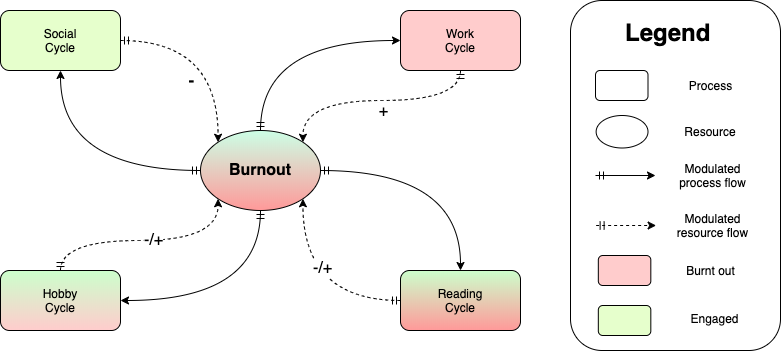
Since the components of burnout, stress and exhaustion, are shared resources across all areas of your life and since stress and exhaustion both modulate each cycle’s verticals in determining whether a spinning a cycle results in a threat cycle or engagement cycle, then burnout in one cycle is often shifts a previously engaged cycle into a threat cycle. I’ve hinted at this before, which exhaustion coming from work can prevent me from savoring positive experiences in my hobbies, which can begin the vicious threat cycle in other areas of my life.
As more engagement cycle become threat cycles, we begin to more broadly disengage from life in general, and that becomes a chief symptom of depression -- lack of interest in life. Paired with unresolved amounts of stress and exhaustion, this begins to look a lot like a depressive episode.
Revisiting the Diagram¶

Now that we have our components, the engagement cycle, the threat cycle, and the burnout cycle, we can combine them by layering the engagement cycle on the outside, the threat cycle on the inside, and the burnout cycle as the innermost cycle.
Throughout the engagement-threat cycles you can see exhaustion variables littered across that flip cycles from one to the other. You can also find the few cognitive mental habits I have in the model that tie the cycles together.
As you explore the diagram more deeply, you can begin to see how the vicious cycle of burnout forms. As we become exhausted from tackling the demands of life, our Engagement Cycles become Threat Cycles, and as we continue to iterate in the Threat Cycle, we create a self-sustaining Burnout Cycle.
I added “Environment factors” in the diagram for completeness since they represent a large portion of research so it felt odd not to include it. These are the external sources of stress and play a large role in most people's burnout.